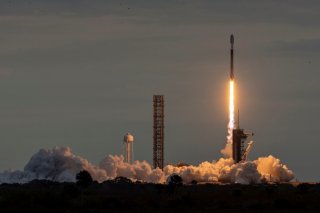The Senate’s NDAA Would Lower Space Force’s Safety Standards
Congress must prioritize reliability and mission success for America’s defense satellite launches.
The establishment of the U.S. Space Force marked a significant milestone in America’s commitment to maintaining its dominance in space. As the guardians of the final frontier, it is imperative that the Space Force maintain the highest standards when it comes to the launch of mission-critical satellites. However, the Senate Armed Services Committee’s recent proposed changes to the launch services procurement process in the 2024 National Defense Authorization Act (NDAA) risk undermining the Space Force’s ability to deploy our most crucial space-based defense assets.
The third phase of the Space Force’s National Security Space Launch Program, which covers launch contracts awarded in 2025, includes a two-lane approach. “Lane 1” allows for multiple vendors and diversity of launch technologies. “Lane 2” will select two medium and heavy-lift rockets vendors that will deploy critical satellites into orbit. The importance of these payloads to the national defense requires reliable launch vehicles and companies with proven processes and capabilities. This dual-lane approach affords ample opportunities for entrants in the launch services to develop and demonstrate new technologies with low-risk missions while ensuring that the nation can respond to threats quickly and reliably.
The Senate Armed Services Committee, apparently bowing to pressure from Blue Origin, proposed on June 23 the creation of a “Lane 2A”. This would allow new entrants in the heavy-lift domain to enter the field several years into the procurement process in the name of increased competition. This misguided change to the process introduces unnecessary uncertainties that can compromise the success of our most vital missions.
Blue Origin has experienced multiple delays in developing the New Glenn rocket and its engines. The engines and the New Glenn are over three years behind schedule, and neither has been flight tested. Indeed, Blue Origin’s launch experience is limited only to its New Shepard suborbital flights, which have been on hiatus since a rocket nozzle failure caused an in-flight abort in September 2022.
Other entrants into the space launch business are experimenting with materials and manufacturing innovations that may—or may not—pave the way for cheaper access to space. Some have proven successful, but only after a rigorous testing process and many flights. Relativity Space lost its first 3D-printed launch vehicle in March this year. Virgin Orbit went bankrupt after the failures of its air-launched two-stage vehicle. Even SpaceX lost several payloads due to failures in the past decade while developing and certifying its Falcon 9.
The recent tragedy of the deep sea “Titan” reminds us of the importance of rigorous testing and gaining experience with new technology over the long term before entrusting it to important missions. While failures can be tolerated with lower-risk flights like those envisioned by Lane 1 of the Space Launch Program, the stakes are too high to jeopardize a Lane 2 mission using unproven technology.
Lane 2 satellite launches are not only costly endeavors but also carry significant national security implications. A failed launch can result in the loss of critical assets or disruption of communication systems. The financial implications of such failures are staggering, as taxpayer dollars are wasted on unsuccessful missions. By prioritizing reliability over competitive experimentation, the Space Force can avoid unnecessary costs associated with failures and allocate resources more efficiently.
Finally, the Space Force operates within a complex ecosystem that involves coordination with multiple government agencies, private contractors, and international partners. The utilization of established vendors ensures a cohesive and accountable framework for collaboration. These vendors have well-defined processes, reliable supply chains, and established relationships with key stakeholders, fostering seamless integration of efforts. Using unproven vendors and new technologies may introduce compatibility issues, potentially jeopardizing the cooperative relationships critical to mission success.
While embracing innovation and exploring new technologies is vital for advancing space exploration, Congress must prioritize reliability and mission success for America’s defense satellite launches. Using established vendors with proven track records, robust testing procedures, and technological maturity is essential to minimize risks and maximize the probability of success. By exercising prudence in its current vendor selection process, the Space Force can uphold its commitment to national security, protect taxpayer investments, and ensure a future of robust space exploration and defense.
Jonathan H. Ward is a freelance writer on the U.S. space program and is the co-author of Bringing Columbia Home: The Untold Story of a Lost Space Shuttle and Her Crew.
Image: Shutterstock.

